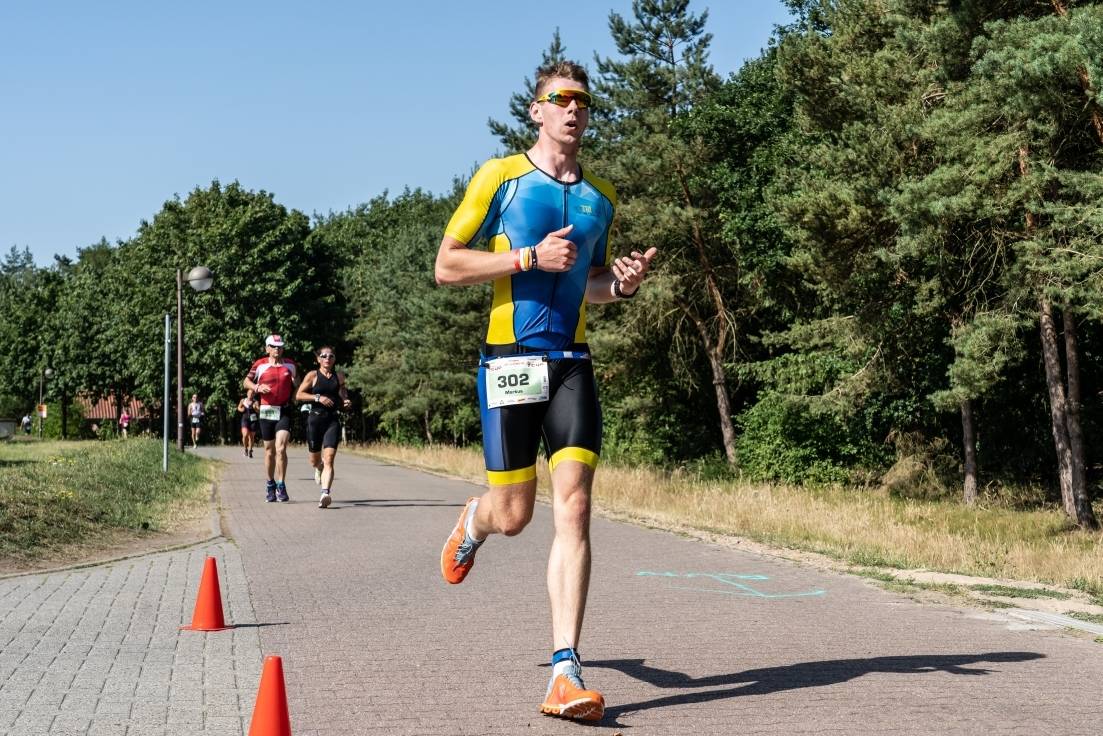Tempohärte an der anaeroben Schwelle - wer es auf den abschließenden 10 Laufkilometern einer Olympischen Distanz richtig krachen lassen möchte, muss in der Lage sein, eine hohe Grundgeschwindigkeit über einen längeren Zeitraum aufrecht halten zu können. Das erfordert spezifisches Lauftraining. Wie ihr für den Laufpart der Kurzdistanz fit werdet, das lest ihr heute:
Weltklasseathleten absolvieren den abschließenden zehn Kilometer-Lauf in rund 30 Minuten, wobei die Gesamtwettkampfdauer circa eine Stunde 45 Minuten beträgt. Da es bei den Amateuren auf gleicher Strecke um Einzel- und Gesamtzeiten von 35 Minuten und 2 Stunden aufwärts geht, beschreibt der oftmals gebrauchte Begriff Kurzdistanz die Anforderungen nur dann treffend, wenn man dieses Wettkampfformat mit dem Ironman- oder Langdistanztriathlon vergleicht. Ansonsten aber gilt: hier ist bereits echte Ausdauer gefragt, doch auch das Tempo ist hoch. Beides muss im Training also entsprechend angesprochen werden.
Ziel: Gewinnen von Tempohärte
Eine tempoorientierte, reine Laufeinheit umfasst beispielsweise 10 x 400 m oder 5 x 800 m auf der Laufbahn. Die zwischen den einzelnen Intervallen liegenden Pausen entsprechen in etwa der Hälfte der Intervalldauer. In diesen „unvollständigen Pausen“ bleibt dem Körper nicht ausreichend Zeit alle Belastungsmarker auf den Ausgangszustand zurückzuführen. Die Intervallgeschwindigkeit kann zwar hochgehalten werden, aber es kommt zu einer graduell ansteigenden Gesamtermüdung. Die Kombination aus Tempo und Ausdauer, oft auch als Tempohärte bezeichnet, wird so effektiv trainiert. Hier ein Beispiel:
Einheit 1 – Gesamtdauer ca. 60 min
15 min Einlaufen
mit 3 Temposteigerungen über 100 m, dann 3 Temposteigerungen über 200 m, dazwischen 300 m bzw. 200 m lockeres Grundlagentempo (das für die Steigerung gewählte Tempo entspricht in etwa dem 10 km Wettkampftempo bei reinen Laufveranstaltungen)
10 x 400 m in jeweils 90 s, Pause zwischen den Intervallen jeweils 45 s
15 min Auslaufen oder Ausradeln
Wahl des Tempos
Amateurathleten auf der Olympischen Distanz verlieren auf ihre zehn Kilometer-Laufzeit bei reinen Laufveranstaltungen in der Regel 10-15 % an Geschwindigkeit. Das in den Intervallen anzustrebende Tempo sollte in dieser reinen Laufeinheit daher ca. 10 % schneller sein als das 10 Kilometer Wettkampftempo. Das bedeutet: läuft ein Athlet bei einem Volkslauf 45 min auf 10 km (4:30 / km), so kann er im Triathlon (u. a. abhängig von der Beschaffenheit der Radstrecke) mit einer Laufzeit von etwa 50 min auf einem äquivalenten Kurs rechnen. Um sich in Einheit Eins dennoch ausreichend zu belasten, sollte er in den Intervallen aber mit 4:00 min/km trainieren.
Training an die Wettkampfstrecke anpassen
Über zehn Kilometer können, abhängig von der Streckenführung als „Out and back“-Kurs, Ein-, Zwei- oder Mehrrundenkurs, auch topographische Gegebenheiten auf der Laufstrecke eine bedeutende Rolle spielen. Für die optimale Umsetzung der individuellen Laufleistung im Triathlon ist daher ein an die Wettkampfstrecke angepasstes Tempotraining zu empfehlen.
Ist zum Beispiel bekannt, dass eine Reihe an 180° Wendepunkten zu absolvieren sind, so sollte das damit unvermeidliche Abbremsen und Beschleunigen gezielt trainiert werden. Ebenso verhält es sich mit Steigungen oder Gefällen, die evt. sogar mehrmals durchlaufen werden müssen. Solche wettkampfspezifischen Einheiten können als Grundlagen- (Einheit 2a) oder Tempotraining (Einheit 2b) absolviert werden.
Einheit 2a – Gesamtdauer ca. 75 min
Für diese im Grundlagenbereich gelaufene Einheit wird eine Strecke oder ein Streckenabschnitt ausgewählt, der in Steigung und/oder Gefälle sowie deren Länge, und/oder Anzahl der Wendepunkte, eine möglichst große Ähnlichkeit mit der Wettkampfstrecke aufweist. Diese Strecke oder dieser Streckenabschnitt wird dann 75 min lang mehrmals durchlaufen. Besonderes Augenmerk gilt dabei der Körperhaltung sowie der Schrittlänge und -frequenz. Wie sind diese einzustellen, um möglichst schnell, aber Kraft sparend voranzukommen? Welche Muskelgruppen sind eventuell besonders beansprucht und sollten zusätzlich isoliert trainiert werden?
Einheit 2b – Gesamtdauer ca. 60 min
Diese Einheit kann am selben Ort wie Einheit 2a durchgeführt werden, man beschränkt sich jedoch auf die Steigung oder das Gefälle oder die Wendepunkte. Diese Abschnitte werden dann mit einer der Einheit Eins äquivalenten Belastungsdauer nach der Intervallmethode zehn bis fünfmal durchlaufen. Bis auf die Wendepunkt-Variante ist die Pausendauer zumeist durch das Zurücklaufen zum Ausgangspunkt festgelegt. Dies sollte ruhig geschehen im Sinne einer aktiven Pause, an die sich sofort ein weiteres Belastungsintervall anschließt. Das Tempo im Belastungsintervall sollte ebenfalls wieder so gewählt werden, dass es einer 10%igen Steigerung gegenüber dem reinen Laufwettkampf auf ähnlicher Strecke entspricht. Hier kann der z.B. in Einheit Eins dafür ermittelte Puls als Anhaltspunkt dienen.
15 min Einlaufen auf dem für die Intervalle vorgesehen Streckenabschnitt
10 x 1:30 min oder 5 x 3:00 min, aktive Pause mit Zurücklaufen zum Ausgangspunkt
15 min Auslaufen oder Ausradeln
Auf der olympischen Distanz hat die muskuläre Ausdauer bereits einen großen Anteil an der Gesamtleistung. Nach mindestens einer Stunde Radfahren, abhängig von der Strecke unter zum Teil hohem Krafteinsatz, ist die Vorermüdung von entscheidender Bedeutung. Um sein rein läuferisches Potenzial auch unter diesen Triathlon-Bedingungen noch maximal auszuschöpfen, sollte auch folgende Einheit in der unmittelbaren Wettkampfvorbereitung (4-2 Wochen vor dem Wettkampf) absolviert werden:
Koppel macht stark
Einheit 3 – Gesamtdauer (nach Radfahren) ca. 20 min
Anschließend an eine eineinhalb bis zweistündige Radeinheit, in der bevorzugt auch Streckenelemente des Wettkampfs berücksichtigt wurden, folgt eine kurze Koppeleinheit über 3 x 1000 m, wobei die 1000 m Intervalle im angestrebten Wettkampftempo im Triathlon gelaufen werden. Die Pause entspricht hier wieder der halben Belastungsdauer. Besonders spezifisch wird diese Einheit, wenn der Laufabschnitt wie in Einheit 2a geschildert absolviert wird.
Training will geplant sein
Alle drei Einheiten innerhalb eines üblichen Sieben-Tage-Zyklus zu absolvieren, ist aufgrund der hohen Belastungen nahezu unmöglich. Um Verletzungen zu vermeiden, bietet sich daher zum Beispiel folgende Struktur an:
Tag 1 (vollständig erholt): Einheit 1
Tag 4 (leicht ermüdet): Einheit 3
Tag 6 (ermüdet): Einheit 2a
Tag 8 (leicht ermüdet): Einheit 2b
Tag 11 (vollständig erholt): Einheit 1 usw.
In den dazwischen liegenden Tagen sollte der Schwerpunkt im Schwimmen und Radfahren beziehungsweise auf der Regeneration liegen. Denn nach wie vor gilt: lieber einmal zu wenig trainiert als einmal zu viel und danach gar nicht mehr!
Entdecke die riesige Trisuit-Kollektion
Vom Basic Einteiler bis hin zum High-End Aerosuit





















1 Kommentar
Andrej H
Interessant..